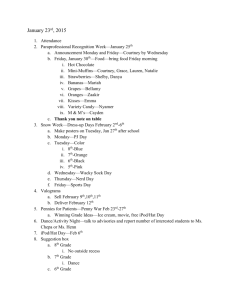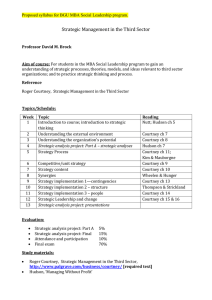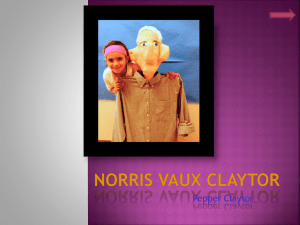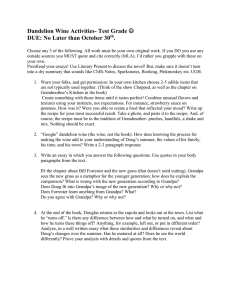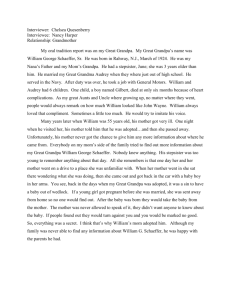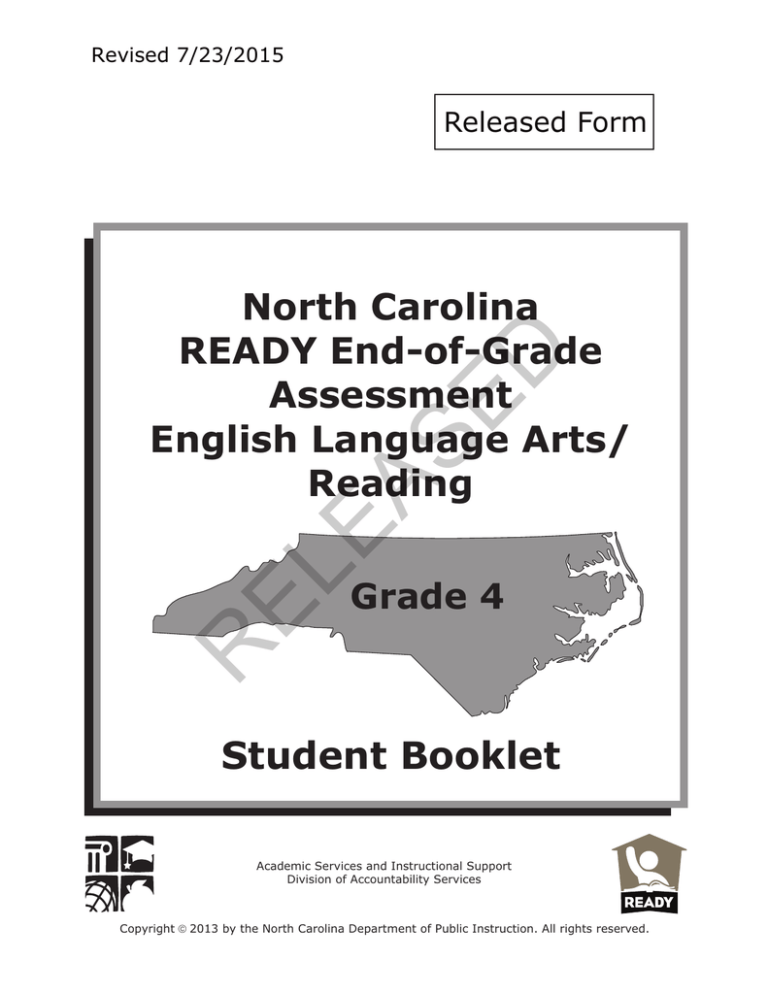
Revised 7/23/2015
Released Form
EL
EA
SE
D
North Carolina
READY End-of-Grade
Assessment
English Language Arts/
Reading
R
Grade 4
Student Booklet
Academic Services and Instructional Support
Division of Accountability Services
Copyright ã 2013 by the North Carolina Department of Public Instruction. All rights reserved.
GRADE 4 ENGLISH LANGUAGE ARTS/READING—RELEASED FORM
Sample Questions
The Rhinoceros
by Oliver Herford
S2
A
calm
B
eager
C
scared
D
upset
EL
How does the Rhinoceros look at the beginning of the poem?
R
S1
Well, since he cares so much for style,
Let’s give him two and see him smile.
EA
10
SE
D
So this is the Rhinoceros!
I wonder why he looks so cross.
Perhaps he is annoyed a bit
Because his clothing does not fit.
5 (They say he got it ready made!)
It is not that, I am afraid.
He looks so cross because I drew
Him with one horn instead of two.
What would change the Rhinoceros’s feelings?
A
giving him new clothing
B
being afraid of his size
C
drawing him with two horns
D
showing off his new style
1
GRADE 4 ENGLISH LANGUAGE ARTS/READING—RELEASED FORM
Grandpa Joe
by J.T. Waite
“Grandpa?” Jake said shyly. Jake wasn’t usually shy when it came to asking his
grandfather about how things were back in the olden days. But asking his grandfather
about his grandfather seemed strange. “Way back when you were little, did you have a
grandpa too?”
D
“Sure,” Grandpa laughed. “Even way back then, we had grandparents. All we were
waiting for was someone to invent uncles and aunts!”
SE
“That’s silly!” Jake said.
“I suppose it is,” Grandpa admitted, “but it’s true. Uncle Sam1 didn’t come along for
years and years. And Aunt Jemima2 wasn’t even in the planning stages.”
EA
“Grandpa!”
EL
Grandpa smiled, “Sure,” he said, “I had a grandpa. I had two grandpas, just like you.
But Pop and Nana, my dad’s folks, lived in Michigan, and I only saw them in the
summer. My Grandpa Joe and my Grandma Jean were right here in town. I saw them
almost every day.”
“Like I see you?” Jake said.
R
“Yup.”
“Was he like you, Grandpa?” Jake asked. “Your Grandpa Joe?”
10
“You mean old and wrinkled?”
“No!” Jake laughed. “I mean nice.”
“He was the nicest man I ever knew,” Grandpa said without a moment’s hesitation.
1
2
Uncle Sam: a symbol from the 1800s used to represent the United States
Aunt Jemima®: a symbol from the 1900s used to represent pancake mix
2
Go to the next page.
GRADE 4 ENGLISH LANGUAGE ARTS/READING—RELEASED FORM
“Everybody liked my Grandpa Joe. Why, he could make a weeping willow3 dry its tears
and laugh out loud.”
“C’mon!” Jake said. “That’s impossible.”
14
“For you or me maybe,” Grandpa said. “But my Grandpa Joe had a way with people.
Made ’em smile.”
“Was he a comedian?” Jake asked. “Like on TV?”
D
“No,” Grandpa chuckled. “Besides, they didn’t have TV back then.”
SE
“No TV?” Jake cried.
“Hard to believe, isn’t it?” Grandpa said. “But somehow they survived.”
“You mean without TV?”
EA
“What did he do?”
“No!” Jake laughed. “What did he do for a living?”
“A glass maker?”
EL
“Lots of different things,” Grandpa said. “He was a glass maker as a young man, then a
mechanic, and finally a night watchman.”
R
“He made glass for windows in a factory downtown in Pennsylvania. Spent almost a
dozen years there doing that. Sent most of what he earned back home to his mom.
Then he moved up here, married my grandmother, and got a job as a mechanic for the
Electric Company. He could fix pretty near anything mechanical, my Grandpa Joe. And
when he got too old for that, he became the night watchman at the same plant.”
“A night watchman isn’t a very important job, is it?”
“To some, maybe not,” Grandpa said. “But Grandpa Joe did lots of important things. He
taught me how to fish. He taught me how to whistle with two fingers in my mouth. He
taught me how to make a fort out of old boxes in the backyard.”
3
weeping willow: a tree with branches that droop
3
Go to the next page.
GRADE 4 ENGLISH LANGUAGE ARTS/READING—RELEASED FORM
“You liked him a lot, didn’t you?” Jake said.
Grandpa smiled. “Not a day goes by that I don’t think about him. And the thing I
remember most is that he always had time for me.”
“You always have time for me, Grandpa.” Jake smiled.
People should spend more time working than with family.
B
People should spend more time with family than working.
C
People should spend more time fishing than building forts.
D
People should spend more time building forts than fishing.
EA
SE
A
Which word describes Jake’s Grandpa?
A
busy
B
shy
C
lazy
D
caring
EL
2
Which statement supports the main idea of this selection?
R
1
D
“You see,” Grandpa said, reaching down to tousle Jake’s unruly hair, “I guess my
Grandpa Joe taught me that’s a grandpa’s most important job.”
4
Go to the next page.
GRADE 4 ENGLISH LANGUAGE ARTS/READING—RELEASED FORM
angry
B
unkind
C
intend
D
cause
D
In paragraph 14, what does Grandpa mean when he says, “But my Grandpa Joe
had a way with people. Made ’em smile”?
Grandpa Joe was a dentist who repaired smiles.
B
Grandpa Joe was always smiling at others.
C
Grandpa Joe’s magic made people excited.
D
Grandpa Joe was friendly and made people happy.
SE
A
EA
5
A
How does Jake feel about his Grandpa spending time with him?
EL
4
Based on paragraph 10, which word is similar to mean?
A
irritated
B
angry
C
fortunate
D
bored
R
3
5
Go to the next page.
GRADE 4 ENGLISH LANGUAGE ARTS/READING—RELEASED FORM
How are Grandpa Joe and Jake’s grandpa alike?
Both spent a lot of time with their grandsons.
B
Both worked as glass makers and mechanics.
C
Both wanted someone to invent aunts and uncles.
D
Both had important jobs when they were young.
EL
EA
SE
D
A
R
6
6
Go to the next page.
GRADE 4 ENGLISH LANGUAGE ARTS/READING—RELEASED FORM
This selection was written in 2008.
Pet’s Best Friend
by Claire Miller
D
Courtney Oliver had wanted to work in a veterinarian’s office for as long as she can
remember. The 10-year-old had often joined her mother in taking her family’s pet dogs
and hamsters to the vet. “It always bugged me when the vet took our dogs to the back
of the office and closed the door,” says Courtney. “I wanted to know what was going
on.”
SE
When the vet finally let Courtney watch her work on the family dogs, Courtney knew she
wanted to learn more. So last year, she signed up for an online course to become a
veterinary assistant. Veterinary assistants help veterinarians with many parts of the
animals’ care. So the course taught Courtney about all of the body systems that keep
the animals alive. Nine months later, Courtney completed the course and began to work
at the office of her family’s vet as a volunteer.
EA
Taking Exams
EL
Since Courtney is too young to work by herself, her mom always goes with her. At the
clinic, Courtney gives the animals baths, sweeps floors, and gets supplies for the vet,
such as bandages and medicines. But her favorite part is assisting the vet during exams.
R
4
Worried owners often bring their furry friends into the office saying that the pet seems
sick. Courtney helps the vet examine the animal to see what is wrong. For instance, vets
closely monitor the animal’s circulatory system, which includes the heart and blood
vessels. In the exam room, the vet listens to the animal’s heart with a stethoscope and
feels its pulse to see how fast the heart is beating. The veterinarian also checks the
respiratory system by observing how fast the animal is breathing. Courtney usually
takes the animal’s temperature. When these numbers are too high or low, the vet knows
something is wrong with the animal.
Operating Room
Courtney says the best part of the day is when the vet talks with her about treatments
for diseases and lets her study X-ray images of the animals’ bones and organs. The vet
sometimes even invites Courtney to watch while she is doing surgery on an animal.
Before entering the operating room, Courtney has to put on the same kind of sterile
7
Go to the next page.
GRADE 4 ENGLISH LANGUAGE ARTS/READING—RELEASED FORM
gown, mask, gloves, and cap that the vet wears. During the surgery, Courtney
sometimes hands the instruments to the vet.
If Courtney has permission from a pet’s owner, she even gets to help. “Some mother
dogs have their babies with an operation called a ‘C’ section,” Courtney explains. After
the vet removes the tiny pups from the mother, Courtney’s job is to rub them to make
sure they start breathing.
New Challenges
D
After spending a year volunteering at her family vet’s office, Courtney wanted to try
some different types of animal care. She is taking another course to learn about animal
massage. Vets sometimes use this method to treat a dog or cat if their muscles are
injured or painful.
SE
Massage can help to relieve the pain and relaxes the animal.
EL
EA
9
Courtney is putting her new knowledge to work in the office of Dr. Susan Neary at
Pilchuck Veterinary Hospital in Washington. Dr. Neary uses special exercises and
massage to help pets that have joint problems, such as knees that hurt when the animal
walks. Dr. Neary often uses special treadmills placed in a shallow pool to help injured
animals exercise safely. In water, a dog puts less pressure on its joints when it walks.
That way it can exercise and strengthen its muscles without hurting them.
R
Courtney says she has learned a lot working in the offices of her family vet and
Dr. Neary. One of the biggest things she learned is to be persistent. “I learned not to let
people tell you you’re too young to learn about something,” she says. “Keep asking until
you find someone to help you follow your dream. But you have to be willing to work
hard!”
8
Go to the next page.
GRADE 4 ENGLISH LANGUAGE ARTS/READING—RELEASED FORM
8
Which statement summarizes the text?
A
A young girl takes dogs for walks to help them get their exercise.
B
A young girl massages injured animals to help them with sore muscles.
C
A young girl starts as a volunteer and decides to become a veterinary
assistant.
D
A young girl wants to become a veterinarian and have her own business.
What is meant by the sentence below?
D
7
Courtney was bothered that she could not be with her dog.
B
There were flies and other insects biting her dogs.
C
Courtney was afraid her dog would never come out.
D
There were other animals that might harm the dogs.
EL
EA
A
How does the author show that Courtney truly wanted to learn about animals?
A
by explaining that Courtney’s mom had to go with her when she was a
volunteer at the family vet
B
by mentioning the difficult course Courtney took to learn about the body
systems of animals
C
by telling that Courtney was glad she was unable to help during the
surgeries
D
by telling how Courtney decided to study for a different career after her
volunteer work
R
9
SE
“ ‘It always bugged me when the vet took our dogs to the back of the office and
closed the door’ ”?
9
Go to the next page.
GRADE 4 ENGLISH LANGUAGE ARTS/READING—RELEASED FORM
Courtney’s mom works at the vet’s office.
B
Courtney needs help to do her jobs at the vet’s office.
C
Courtney does not know how to take care of animals.
D
Courtney is not an adult and must have a parent with her.
D
In paragraph 4, what is the meaning of stethoscope?
a type of care to help relieve an animal’s pain
B
a method used to relax animals during medical exams
C
a device used to measure an animal’s temperature
D
an instrument used to hear the heartbeat of an animal
SE
A
EA
12
A
Why is Courtney unable to perform surgeries on animals in the veterinary office?
A
Courtney’s mother will not allow her to operate.
B
Only veterinarians can perform surgeries.
C
Only veterinary assistants are able to operate.
D
Courtney is not old enough to perform surgeries.
EL
11
Why does Courtney’s mom always go with her when she works at the vet’s office?
R
10
10
Go to the next page.
GRADE 4 ENGLISH LANGUAGE ARTS/READING—RELEASED FORM
how Courtney and Dr. Neary help animals with joint problems
B
how Courtney took online courses to learn about animal care
C
how Courtney calms down owners who are worried about their pets
D
how Courtney and her family vet perform surgery on injured pets
It is comfortable for them.
B
They enjoy getting wet.
C
It is easier on their joints.
D
They need the exercise.
SE
A
D
According to the selection, why do some animal exercises take place in shallow
water?
EA
15
A
How does the author show that Courtney wants to become a vet?
EL
14
What is the main idea of paragraph 9?
A
by listing all the work and courses that Courtney completes to gain
knowledge
B
by writing about Courtney pet sitting for her neighbors
C
by writing about the business where Courtney wants to work
D
by listing books Courtney reads about becoming a vet
R
13
11
Go to the next page.
GRADE 4 ENGLISH LANGUAGE ARTS/READING—RELEASED FORM
The Happy Sheep
by Wilfred Thorley
All through the night the happy sheep
Lie in the meadow grass asleep.
Their wool keeps out the frost and rain
Until the sun comes round again.
They have no buttons to undo,
Nor hair to brush like me and you.
D
5
17
EL
Which statement summarizes the poem?
A
Sheep are happy because they can sleep all night in the meadow.
B
Sheep are happy because they have everything they need.
C
Sheep are happy because they do not have buttons to undo.
D
Sheep are happy because they have wool to protect them from the weather.
R
16
Or rise and walk about and eat
The carpet underneath their feet.
EA
10
SE
And with the light they lift their heads
To find their breakfast on their beds,
What is the effect of giving human qualities to the sheep?
A
to show how much sheep sleep each day
B
to show that sheep eat the same food as people
C
to show that sheep have an easier life than people
D
to show how sheep like to have their wool brushed
12
Go to the next page.
GRADE 4 ENGLISH LANGUAGE ARTS/READING—RELEASED FORM
a room with carpet
B
a room with a bed
C
a meadow
D
a forest
D
What is the meaning of line 4?
until the sun goes down at night
B
until the sun comes out the next morning
C
until the sun hides behind the winter winds
D
until the sun is hot enough to make them sweat
SE
A
EA
20
A
What is the meaning of lines 7–10?
A
The sheep use a lamp to wake up in the morning.
B
The sheep keep a lamp near their bed every night.
C
Their breakfast is brought to them each morning.
D
Their bed is a meadow where they can eat.
EL
19
Which describes the setting of the poem?
R
18
13
Go to the next page.
GRADE 4 ENGLISH LANGUAGE ARTS/READING—RELEASED FORM
According to line 10, what does the word carpet represent?
dirt
B
wool
C
sand
D
grass
EL
EA
SE
D
A
R
21
14
Go to the next page.
GRADE 4 ENGLISH LANGUAGE ARTS/READING—RELEASED FORM
You’re a Poet, Now Let Them Know It
by Lee Pelham Cotton
Your poems are a hit with your family and friends. What about taking the next
step—sharing your work with a large audience? If you’ve dreamed of having your poems
appear in print or win a prize in a contest, read on . . .
To Market, to Market
Your school’s literary magazine, your hometown newspaper, and local contests for
National Poetry Month are all great places to start submitting your work.
•
Visiting the periodicals section of the library will reveal more markets. Check out
writers’ guidelines on the web sites of promising magazines.
•
Poet’s Market lists over 1,500 magazines, books, and contests of interest to poets,
including nearly 100 markets in its “Poetry by Children” section. It also offers
great “how-to” publishing information, interviews, and articles.
•
Entering contests prompts you to write about new subjects and try different poetic
forms. The National Federation of State Poetry Societies sponsors dozens of
contests annually, some just for students.
EL
EA
SE
D
•
Playing the Game
5
If you want your manuscript to be considered seriously by editors and contest
judges, take their rules seriously. Follow the rules and you’ll be ahead of the
game!
R
•
Don’t give up!
•
And be patient. Editors often receive thousands of submissions a year. Don’t stop
writing. Don’t stop submitting. Don’t give up!
15
Go to the next page.
GRADE 4 ENGLISH LANGUAGE ARTS/READING—RELEASED FORM
Keep Good Records
•
Start a loose-leaf notebook containing all your poems, with a “Fate of” sheet for
each. Every time you submit a poem, note the date, the market, and the outcome
of the submission.
EA
SE
D
of ...
Fate
Neatness Counts
Print a new copy of your manuscript for each submission, using white paper and a
black font that’s easy to read. Double-check for spelling, punctuation and
grammatical errors. And always include an SASE so the editor can get back to you.
EL
•
•
R
If at First You Don’t Succeed . . .
Rejection is a part of the publishing process, especially for beginning writers. Don’t
let rejection make a quitter out of you! Keep resubmitting your poems—you may
be just one market or submission away from success.
16
Go to the next page.
GRADE 4 ENGLISH LANGUAGE ARTS/READING—RELEASED FORM
Some Useful Terms
Editor
the person who selects
manuscripts for a
publication
Manuscript
your poem, whether in
paper or electronic form
SE
D
Market
a publication or contest
that is interested in
receiving
submissions
EA
Rejection
when your work is not
chosen for a publication
R
EL
SASE
a stamped, self-addressed
envelope, usually a #10
business size
Submission
the writing you offer to an
editor or contest
Submit
to offer your writing to an
editor or contest
Writer’s Guidelines
describe what kind of
poems a publication is
interested in seeing as well
as the rules for submitting
manuscripts
17
Go to the next page.
GRADE 4 ENGLISH LANGUAGE ARTS/READING—RELEASED FORM
The library has a lot of good information to help people write poems.
B
Be sure to follow all grammar rules when writing a poem.
C
A person who writes poems should submit them for publishing.
D
Many people write poems and never get published.
D
According to the selection, why is it important to visit the library?
to find information about upcoming contests
B
to find a quiet place to write poetry
C
to learn what judges are looking for
D
to publish a book of poetry
SE
A
EA
24
A
Which summarizes the section “Playing the Game”?
A
Check for spelling errors.
B
Never give up.
C
Send gifts to the judges.
D
Follow the rules.
EL
23
Which statement summarizes the text?
R
22
18
Go to the next page.
GRADE 4 ENGLISH LANGUAGE ARTS/READING—RELEASED FORM
stopped for
B
left alone
C
tested on
D
thought about
mistakes in libraries
B
mistakes in drawings
C
mistakes made in reading
D
mistakes made in writing
SE
A
D
Based on the selection, what are “grammatical errors”?
EA
27
A
Why did the author include a list of useful terms at the end of this selection?
A
to help the reader understand the meaning of unfamiliar words
B
to explain the steps in submitting a poem to a magazine
C
to give a summary of the steps for publishing a poem
D
to tell how to pronounce unfamiliar words
EL
26
Based on paragraph 5, what does considered mean?
R
25
19
Go to the next page.
GRADE 4 ENGLISH LANGUAGE ARTS/READING—RELEASED FORM
a tool used to send manuscripts
B
an idea for poems that are edited separately
C
a group of writings that are printed together
D
an envelope used to hold written work
D
According to the chart, what is a submission?
a group of people who read poems sent to a magazine
B
a contest that is interested in receiving poems
C
the writing that is sent to an editor
D
a list of rules for entering a writing contest
SE
A
EA
30
A
According to the text and the illustration, what is important to include with each
poem sent to a publisher?
EL
29
In the selection, what is a publication?
A
a self-addressed, stamped envelope
B
a list of dates that each poem was written
C
an ink pen
D
a notebook
R
28
20
Go to the next page.
GRADE 4 ENGLISH LANGUAGE ARTS/READING—RELEASED FORM
The Eerie, Haunting, Terrible Cry
by Sandra Beswetherick
Even before I reached the tent, I knew there would be trouble. My little brother was
following me, his arms heaped with a sleeping bag, a flashlight, and his stuffed bear.
“Oh no,” my friend Wade said. “What did you bring him for?”
D
The other guys moaned and groaned so much you’d think they were hospital patients
instead of kids I’d invited for an outdoor sleepover.
SE
“He wanted to come. My mom said he could,” I answered, not exactly happy about Andy
tagging along. I didn’t need to be embarrassed.
“He’ll ruin everything,” Wade insisted. “He’ll get scared in the middle of the night and
have to be taken back to the house.”
EA
“No, I won’t!” Andy said, showing Wade his fiercest face.
“Get in,” I said.
EL
I’d made Andy promise that he wouldn’t ruin anything and that he’d make himself
invisible in the tent corner farthest from me.
R
Andy wormed his way into the tent—getting tangled in sleeping bags, tripping over
feet—until he reached the far corner, where he settled in. Night was settling in too, with
the woods around us fading toward black. The house, with its porch light, seemed a long
way from us.
“Time for ghost stories!” Brad announced as soon as I’d closed the tent flap. He told a
story about vampires, but it only made us fall over laughing.
Next was Mike. He whispered a creepy tale about cemeteries and zombies.1 Right in the
middle, something landed on the tent. We all looked up.
“Leaves,” I said. “Only leaves falling.”
1
zombies: a type of fictional monster
21
Go to the next page.
GRADE 4 ENGLISH LANGUAGE ARTS/READING—RELEASED FORM
When it was Wade’s turn, he held the flashlight under his chin, turning his face into a
shadowy mask. “These four guys were camping in a tent,” he began, describing our
situation exactly—except for Andy. “Wandering the woods nearby was this creature, one
that was all teeth and claws and appetite.”
Somewhere outside, a twig snapped. The hairs on my arms pricked.
“These guys were crawling into their sleeping bags, right?” Wade said. “When out of the
darkness rang this eerie, haunting, terrible cry.”
D
And out of the woods behind us there was a cry! High-pitched, eerie, and inhuman. The
hairs on my head shot straight up.
“What was that?” Mike asked as the cry came again.
SE
Brad looked from Mike to Wade. Wade looked at me.
“I don’t know!” I said.
“Why don’t you?” I asked.
EA
“Maybe you should check,” Wade suggested.
R
“What?” I said.
EL
An anxious voice interrupted. “What if it’s something trapped or hurt?” We focused our
flashlights on Andy, whom we’d forgotten, sitting in the corner with his arms around his
bear. Andy, who would adopt every lost or hurt animal in the world if Mom would let
him.
“It sounds like something trapped or hurt,” he insisted. “We have to save it.”
“You have no idea what it is,” Wade said. “What if it’s a ghost?”
Wade would have to say something like that. Not that I believed in ghosts, but would a
ghost make a sound like that?
“I’m going to see,” Andy said as he scrambled to the front of the tent. Still, I could tell
he was scared from the way he was hanging on to his bear.
Andy unzipped the tent flap, and he was gone.
22
Go to the next page.
GRADE 4 ENGLISH LANGUAGE ARTS/READING—RELEASED FORM
“Andy!”
I had to go after him. He was my little brother. “One of you guys run to the house and
get my dad,” I said, not knowing if any of them had the courage to dash across the long
dark yard.
Andy was headed into the woods, his flashlight beam wobbling along the trail. “Andy!” I
yelled again.
SE
D
32
I’d walked that trail hundreds of times during the day and a few times at night with Dad.
But now, under the beam of my flashlight, shadows shifted and leaped, attacking me
from all sides. In my imagination, hideous monsters lurked behind every tree. My heart
pounded.
“Andy!”
EA
Then I saw him, a few yards ahead, with his flashlight aimed at the upper branches of a
large tree. I raised my own light to shine on the same spot. A pair of luminous2 eyes
seemed to float in the darkness. My heart pounded harder.
“It’s a little animal,” Andy whispered.
R
EL
36
Then I heard a rustle in the bushes behind us. We swung around, flashlights pointed,
and a creature lumbered out. A creature with teeth and claws . . . and covered in quills.
As soon as it began clambering up the tree toward the glowing eyes, the high-pitched
cries stopped.
“A happy ending,” Andy said. “The baby porcupine was lost, and he was crying for his
mama.”
38
I knew he was right, although I hadn’t known before that porcupines had voices. The
little porcupine was climbing down toward its mother. My heart lifted like a helium
balloon.
I turned toward Andy, who was smiling and clutching his bear. “You know, Andy,” I said,
2
luminous: bright, glowing
23
Go to the next page.
GRADE 4 ENGLISH LANGUAGE ARTS/READING—RELEASED FORM
reaching over to pat his shoulder, “for a kid brother, you can be one impressive little
guy.”
As we walked down the trail toward home, I could see all the guys huddled under the
porch light, with Dad throwing his jacket on over his pajamas.
“Hey,” Wade hollered, “are you all right?”
SE
Sleepovers with scary stories are always fun.
B
Sleepovers can be frightening when camping in the woods.
C
Andy told the scariest stories and was the most scared of all.
D
Andy, who was not welcomed by everyone, proved to be the bravest of all.
EA
A
EL
32
Which statement summarizes the selection?
Why were the speaker’s friends upset with him at the beginning of the selection?
A
He would not tell scary ghost stories.
B
His little brother was staying with them.
C
He brought stuffed animals into the tent.
D
His little brother was ruining the sleepover.
R
31
D
“We’re fine,” I answered with a grin, knowing that Wade’s opinion of Andy would
change, too. “And that creature you were telling us about? It’s fine, too.”
24
Go to the next page.
GRADE 4 ENGLISH LANGUAGE ARTS/READING—RELEASED FORM
His little brother ran and found what was causing the scary noise.
B
His little brother told the scariest stories of anyone he knew.
C
His little brother became afraid listening to the stories and went back inside.
D
His little brother ran to the house to get their father.
confident
B
frightened
C
calm
D
excited
SE
A
D
Based on paragraph 32, which word describes the speaker?
EA
35
A
As used in paragraph 36, what is the meaning of quills?
EL
34
Which event from the story caused the speaker to change his mind about his little
brother?
A
the large wing or tail feathers of a bird
B
feathers formed into pens used for writing
C
devices used for plucking guitar strings
D
the hollow spines on a porcupine
R
33
25
Go to the next page.
GRADE 4 ENGLISH LANGUAGE ARTS/READING—RELEASED FORM
In paragraph 38, which could replace “My heart lifted like a helium balloon”?
The narrator felt a great sense of fear.
B
The narrator’s heart felt light and weightless.
C
The narrator felt a great sense of relief.
D
The narrator felt heavy in his chest.
EL
EA
SE
D
A
R
36
26
Go to the next page.
GRADE 4 ENGLISH LANGUAGE ARTS/READING—RELEASED FORM
Excerpt from On the Bus with Joanna Cole
by Joanna Cole
D
The basic idea for the Magic School Bus books came from an editor at Scholastic, Craig
Walker. Craig was a big fan of the Clown-Around books. He was also the editor of the
See-Saw Book Club at Scholastic. He was looking for a way to get kids more interested
in science books, and he had the idea of a humorous book about a teacher who takes
her class on magical field trips to learn about science. But he didn’t have anyone to write
the book. One day, Craig realized that the Clown-Arounds author was the same author
who had written so many serious science books—me. He picked up the phone and dialed
my number.
EL
EA
SE
2
I was enchanted with the idea. I thought it would be so much fun to write. Craig and I
met and tossed around ideas for exciting places the class might visit: the moon; the
Egyptian pyramids; prehistoric times. Craig also mentioned that they might visit the
town waterworks. This he thought was not such an exciting place. But I loved it because
I imagined that the teacher would be enthusiastic about the trip, while the children
would think, “How boring!” I thought this combination would make the book funny, and I
knew that it could be successful only if the science was rock solid and the plot was
exciting and humorous.
R
One of my tasks in coming up with the Magic School Bus books was to develop the
teacher’s character. Craig had talked about his teachers, and, as I created Ms. Frizzle, I
found myself remembering mine from elementary and junior high school. Did I have a
teacher like Ms. Frizzle? Yes and no. None of my science teachers in East Orange had
magical powers on field trips, but they were the best. One teacher, Miss Bair, was my
favorite. Like Ms. Frizzle, she was very serious about science. She did not try to “make it
interesting to kids,” she just communicated her own interest to us. Like Ms. Frizzle, she
just barged ahead doing an experiment with Ping-Pong balls and a vacuum cleaner or
manipulating a model of an atom—so involved in what she was doing that she blithely*
ignored our reactions. My Ms. Frizzle does the same thing—pulling the kids along on the
coattails of her own excitement in her subject. (The Ms. Frizzle in the books acts like
Miss Bair, but looks like Bruce Degen’s high school geometry teacher, Miss Isaacs.)
As an adult, I remembered Miss Bair with affection and admiration. Imagine my
*
blithely: cheerfully
27
Go to the next page.
GRADE 4 ENGLISH LANGUAGE ARTS/READING—RELEASED FORM
surprise, then, when after having written several Magic School Bus books, I discovered
my eighth-grade diary under a pile of sweaters and turned to an entry about science
class. There was a most unflattering description of my favorite teacher. I called her “Old
Lady Bair” and the comments from me and my classmates could have come straight out
of the mouths of Magic School Bus kids. It was then that I realized that the kids in my
books may say that the Friz is weird, and they may groan when she announces a field
trip, but in their hearts they love and admire her—even Arnold!
SE
D
Whenever we think about ideas for Magic School Bus books (“we” being me, Bruce
Degen, and the editors at Scholastic) we try to come up with “big” topics that kids,
teachers, and parents are interested in and think are important. For instance, we did a
book about ocean science, rather than a whole book about sharks or seaweed. We did
the human body, not the mouth and the ear. We did the solar system, not a whole book
about a single planet.
R
EL
EA
Usually when an idea comes—let’s say it’s the solar system—I already have a general
idea of the structure of the book. I know right away that the bus will have to turn into a
spaceship so that the class will visit each planet. At first, I don’t know what events will
lead up to this. But pretty soon, ideas start forming. I picture the class in school, then I
ask myself, how will they get started on the trip? And it occurs to me that they’ll be
going to the planetarium and get sidetracked into space. To make things a little
different, I think of having Arnold’s cousin, Janet, visit the class. All this goes into a
two-page essay/outline that I send off to my editor. As I keep thinking, researching, and
eventually writing the story, I get ideas for the details: I figure out that the class can’t
go to the planetarium because it’s closed that day and they have to go to outer space
instead, I write word balloons for Janet and she turns into a know-it-all, and by the time
the bus/spaceship gets to the asteroid belt, I need a plot element to make things more
exciting, so the Friz gets lost in space and the kids are left on their own.
7
At the same time that I am fleshing out the plot and giving the characters things to say,
I am still reading, reading, reading about my subject. I want the science to be rock
solid.
28
Go to the next page.
GRADE 4 ENGLISH LANGUAGE ARTS/READING—RELEASED FORM
bored
B
hopeful
C
curious
D
delighted
anxious
B
eager
C
nervous
D
bored
SE
A
D
In paragraph 2, what is the meaning of enthusiastic?
EA
39
A
What did the author think would make the Magic School Bus books successful?
A
making the plots exciting while filling the books with science facts
B
having the characters visit common places
C
making the children in the books more excited than their teacher
D
filling the books with colorful pictures
EL
38
In the first sentence of paragraph 2, what is the meaning of enchanted?
R
37
29
Go to the next page.
GRADE 4 ENGLISH LANGUAGE ARTS/READING—RELEASED FORM
a teacher from a children’s TV show
B
her daughter’s fourth-grade teacher
C
a teacher she saw on the news
D
one of her old science teachers
her own
B
Miss Isaacs’s
C
Miss Bair’s
D
Bruce Degen’s
SE
A
D
According to the author, who does Ms. Frizzle’s teaching resemble?
EA
42
A
What is something the author does when she has an idea for another Magic School
Bus book?
EL
41
Where did the author get the idea for her main character, Ms. Frizzle?
A
She writes a two-page outline and sends it to her editor.
B
She writes everything quickly before she loses her thoughts.
C
She reads one of the other Magic School Bus books.
D
She asks her old teacher and editors to help her.
R
40
30
Go to the next page.
GRADE 4 ENGLISH LANGUAGE ARTS/READING—RELEASED FORM
A
leaving alone
B
making better
C
worrying about
D
writing over
cause and effect
B
sequence of events
C
description of objects
D
compare and contrast
EA
A
SE
D
What does the author use to explain how the Magic School Bus books were
created?
EL
44
In paragraph 7, what is the meaning of “fleshing out”?
R
43
31
Go to the next page.
GRADE 4 ENGLISH LANGUAGE ARTS/READING—RELEASED FORM
This is the end of the English Language Arts/Reading test.
Directions:
1. Look back over your answers for the test questions.
2. Put all of your papers inside your test book and close your test book.
R
EL
EA
SE
D
3. Stay quietly in your seat until your teacher tells you that testing is
finished.
32
D
SE
EA
ACKNOWLEDGMENTS
EL
The North Carolina Department of Public Instruction wishes to express gratitude to the following
authors and publishers, whose generous permission to reprint literary selections has made these
tests possible. Every effort has been made to locate the copyright owners of material reprinted in
this test booklet. Omissions brought to our attention will be corrected in subsequent editions.
R
“Grandpa Joe” by J.T. Waite from Boys’ Quest, February/March 2006, Vol. 11. Copyright © 2006.
Reprinted by permission of Boys’ Quest magazine.
“Pet’s Best Friend” by Claire Miller from Scholastic SuperScience, September 2008. Copyright
© 2008 by Scholastic Inc. Reprinted by permission of Scholastic Inc.
“The Happy Sheep” by Wilfred Thorley first appeared in The Merry-Go-Round: The Monthly
Magazine for Children, published by Basil Blackwell, Ltd. (UK), 1923–1939.
“You’re a Poet, Now Let Them Know It” by Lee Pelham Cotton from Appleseeds issue: Playing with
Words, © 2010 Carus Publishing Company. Reproduced with permission. All Cricket Media material
is copyrighted by Carus Publishing Company, d/b/a Cricket Media, and/or various authors and
illustrators. Any commercial use or distribution of material without permission is strictly prohibited.
Please visit http://www.cricketmedia.com/info/licensing2 for licensing and http://cricketmedia.com
for subscriptions.
“The Eerie, Haunting, Terrible Cry” by Sandra Beswetherick from Highlights for Children, May 2001.
Copyright © 2001 by Highlights for Children, Inc., Columbus, Ohio.
Excerpt from On the Bus with Joanna Cole: A Creative Autobiography by Joanna Cole. Copyright
© 1996 by Joanna Cole. Reprinted by permission of the author.


